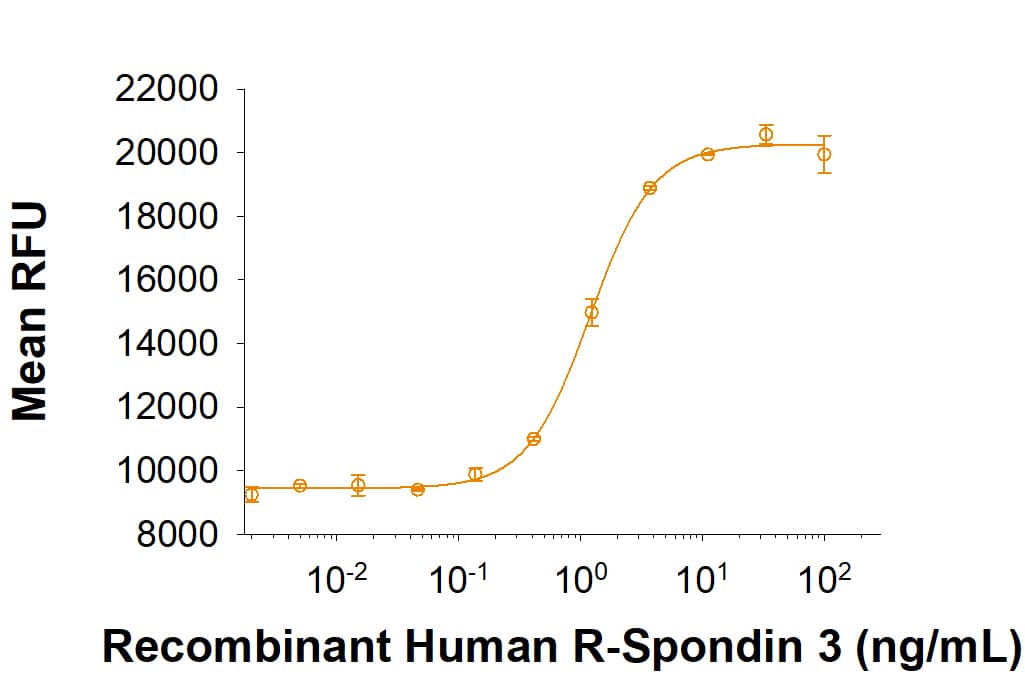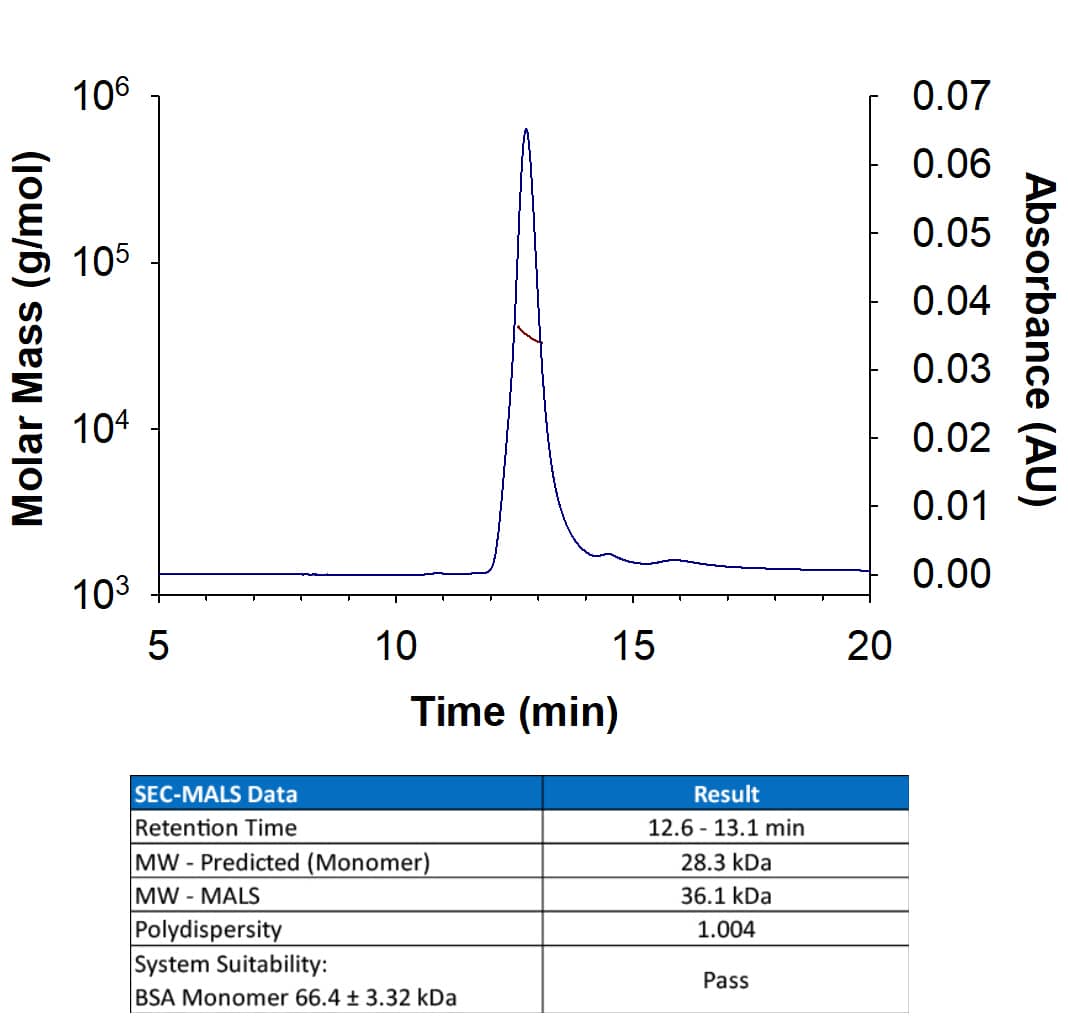Recombinant Human R-Spondin 3 Protein Best Seller
R&D Systems, part of Bio-Techne | Catalog # 3500-RS

Key Product Details
Product Specifications
Source
Gln22-His272
Purity
Endotoxin Level
N-terminal Sequence Analysis
Predicted Molecular Mass
SDS-PAGE
Activity
The ED50 for this effect is 0.500‑2.00 ng/mL in the presence of 5 ng/mL Recombinant Mouse Wnt‑3a (Catalog # 1324-WN).
Scientific Data Images for Recombinant Human R-Spondin 3 Protein
Recombinant Human R‑Spondin 3 Protein SEC-MALS.
Recombinant human R-Spondin 3 (Catalog # 3500-RS) has a molecular weight (MW) of 36.1 kDa as analyzed by SEC-MALS, suggesting that this protein is a monomer. MW may differ from predicted MW due to post-translational modifications (PTMs) present (i.e. Glycosylation).Recombinant Human R-Spondin 3 Protein Bioactivity
Recombinant Human R-Spondin 3 (Catalog # 3500-RS), in the presence of Recombinant Mouse Wnt 3a (Catalog # 1324-WN; 5 ng/mL), induces activation of beta-catenin in HEK293T cells measured using the Topflash assay. The ED50 for this effect is 0.50-2.00 ng/mL.Recombinant Human R-Spondin 3 Protein Lot-to-Lot Consistency
The lot-to-lot consistency of Recombinant Human R-Spondin 3 (Catalog # 3500-RS) was assessed by testing the ability of three independent lots of the protein to stimulate activation of beta-Catenin using a TOPflash beta-Catenin/TCF reporter assay in the HEK293T human kidney cell line, in the presence of 5 ng/mL Recombinant Mouse Wnt-3a (1324-WN). Each trace on the graph represents data obtained from Recombinant Human R-Spondin 3 from a different manufacturing run. The ED50 for this effect is 0.500-2.00 ng/mL in the presence of 5 ng/mL Recombinant Mouse Wnt-3a.Formulation, Preparation and Storage
Carrier Free
What does CF mean?CF stands for Carrier Free (CF). We typically add Bovine Serum Albumin (BSA) as a carrier protein to our recombinant proteins. Adding a carrier protein enhances protein stability, increases shelf-life, and allows the recombinant protein to be stored at a more dilute concentration. The carrier free version does not contain BSA.
What formulation is right for me?In general, we advise purchasing the recombinant protein with BSA for use in cell or tissue culture, or as an ELISA standard. In contrast, the carrier free protein is recommended for applications, in which the presence of BSA could interfere.
Carrier: 3500-RS
| Formulation | Lyophilized from a 0.2 μm filtered solution in PBS with BSA as a carrier protein. |
| Reconstitution | Reconstitute at 100 μg/mL in PBS containing at least 0.1% of human or bovine serun albumin. |
| Shipping | The product is shipped at ambient temperature. Upon receipt, store it immediately at the temperature recommended below. |
| Stability & Storage | Use a manual defrost freezer and avoid repeated freeze-thaw cycles.
|
Carrier Free: 3500-RS/CF
| Formulation | Lyophilized from a 0.2 μm filtered solution in PBS. |
| Reconstitution | Reconstitute at 100 μg/mL in PBS. |
| Shipping | The product is shipped at ambient temperature. Upon receipt, store it immediately at the temperature recommended below. |
| Stability & Storage | Use a manual defrost freezer and avoid repeated freeze-thaw cycles.
|
Background: R-Spondin 3
R-Spondin 3 (RSPO3, roof plate-specific spondin 3), also called cysteine-rich and single thrombospondin domain containing-1 (Cristin 1), is an ~31 kDa secreted protein that shares ~40% amino acid (aa) identity with the other three R-Spondin family members (1, 2). All are positive modulators of Wnt/ beta-catenin signaling, but each has a distinct expression pattern (1-4). Like other R-spondins,R-Spondin 3 contains two adjacent cysteine-rich furin-like domains (aa 35-135) with one potential N-glycosylation site (aa 36), followed by a thrombospondin (TSP-1) motif (aa 147-207) and a region rich in basic residues (aa 211-269). Only the furin-like domains are needed for beta-catenin stabilization (2). Within aa 21-209, human R-Spondin 3 shares 93%, 92%, 97%, 96% and 92% aa identity with mouse, rat, equine, bovine and canine R-Spondin 3, respectively. Potential isoforms of 279 and 297 aa diverge at aa 210 and 276, respectively (5). Mouse R-Spondin 3 is critical for development of the placental labyrinthine layer, probably by promoting VEGF expression and thus vascular development (6, 7). It is also essential for expression of the placenta-specific transcription factor, Gcm1. In the mouse embryo, R-Spondin 3 is often expressed by or located near endothelial cells (6). It is found in the roof plate, tail, somites, otic vesicles, cephalic mesoderm, truncus arteriosus, atrioventricular canal of the developing heart, and strongly but transiently in developing limbs (4, 7). R-Spondins regulate Wnt/ beta-catenin by competing with the Wnt antagonist DKK-1 for binding to the Wnt co-receptors LRP-6 and Kremen, reducing their DKK-1-mediated internalization (8, 9). Reports differ on whether R-Spondins bind LRP-6 directly (8-10). R-Spondin 3 has also been identified as an oncogene (11).
References
- Chen, J-Z. et al. (2002) Mol. Biol. Rep. 29:287.
- Kim, K.-A. et al. (2008) Mol. Biol. Cell 19:2588.
- Hendrickx, M. and L. Leyns (2008) Develop. Growth Differ. 50:229.
- Nam, J.-S. et al. (2007) Gene Expr. Patterns 7:306.
- Entrez Accession # EAW48114 and EAW48116.
- Kazanskaya, O. et al. (2008) Development 135:3655.
- Aoki, M. et al. (2007) Dev. Biol. 301:218.
- Binnerts, M.E. et al. (2007) Proc. Natl. Acad. Sci. USA 104:14700.
- Nam, J.-S. et al. (2006) J. Biol. Chem. 281:13247.
- Wei, Q. et al. (2007) J. Biol. Chem. 282:15903.
- Theodorou, V. et al. (2007) Nat. Genet. 6:759.
Long Name
Alternate Names
Gene Symbol
UniProt
Additional R-Spondin 3 Products
Product Documents for Recombinant Human R-Spondin 3 Protein
Product Specific Notices for Recombinant Human R-Spondin 3 Protein
For research use only


